Outline of the Palestinian territories
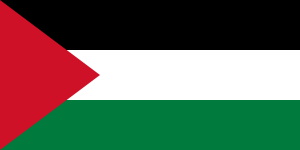
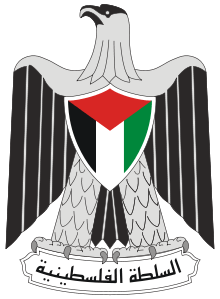

.png)


The following outline is provided as an overview of and topical guide to the Palestinian territories:
Palestinian territories – West Bank and the Gaza Strip, politically under the jurisdiction of the Palestinian National Authority the Hamas Government in Gaza, and the Israeli Civil Administration. Since the Palestinian Declaration of Independence in 1988, the region is today recognized by three-quarters of the world's countries to be the State of Palestine.[1] Although recently promoted to a non-member state status in the UN, the State of Palestine is not recognized by Israel and major Western nations, including the United States.
General reference
- Pronunciation: /ˈpælɨstaɪn/
- Common English country names: Palestinian territories; Occupied Palestinian Territories/Occupied Palestinian Territory/Palestinian Territory, Occupied; Palestinian Authority territories; Palestinian Authority areas; West Bank and Gaza Strip
- Official English country name: U.S. State Department: Palestinian Territories ; E.U. ISO 3166-1: Palestinian Territory, Occupied ; UN-affiliated organizations: Occupied Palestinian Territory
- Common endonym(s): al-ʼarāḍi-l-filasṭinīya (Arabic: الأراضي الفلسطينيّة); filasṭīn (Arabic: فلسطين, also transliterated falasṭīn and filisṭīn; al-ʼarāḍi-l-muḥtalla
- Official endonym(s): N/A
- Adjectival(s): Palestinian
- Demonym(s): Palestinian people (aš-šaʿb al-filasṭīnīy), Palestinians (al-filasṭīnīyūn) or Palestinian Arabs (al-ʿarab al-Filasṭīnīyūn)
- Etymology: Timeline of the name Palestine, Name of Palestine, Place names in Palestine
- ISO country codes: PS, PSE, 275
- ISO region codes: See ISO 3166-2:PS
- Internet country code top-level domain: .ps
Geography of the Palestinian territories

- The Palestinian territories are: Israeli-occupied/Semi-autonomous region, with status to be determined by further negotiations
- Location:
- Northern Hemisphere and Eastern Hemisphere
- Eurasia
- Asia
- Southwest Asia
- Asia
- Time zone: UTC+02, summer UTC+03
- Extreme points of the Palestinian territories
- High: Mount Nabi Yunis 1,030 m (3,379 ft)
- Low: Dead Sea −412 m (−1,352 ft) – lowest point on the surface of the Earth
- Land boundaries: Officially undefined, figures given are the de facto boundaries of the Green Line as they apply to the West Bank and Gaza Strip (See also Israeli West Bank barrier, Israeli Gaza Strip barrier and the Seam Zone)
- Total: 466 km (290 mi)
- Coastline: Mediterranean Sea 40 km (25 mi)
- Population of the Palestinian territories:
- Palestinian population worldwide, including diaspora: est. 10,000,000 - 11,000,000
- Population of the Palestinian territories: est. 3,800,000
- Area of the Palestinian territories:
- Palestinian territories (post-1967): 6,220 km2 (2,400 sq mi); The West Bank (including East Jerusalem) is (5,860 km2 (2,260 sq mi) and the Gaza Strip is 360 km2 (140 sq mi)
- Atlas of Palestine
Environment of the Palestinian territories




- Climate of the Palestinian territories
- Ecoregions in the Palestinian territories
- Renewable energy in the Palestinian territories
- Solar cookers in Gaza
- Geology of the Palestinian territories
- Protected areas of the Palestinian territories
- Biosphere reserves in the Palestinian territories
- National parks of the Palestinian territories
- Wildlife of the Palestinian territories
- Flora of the Palestinian territories
- List of native plants of Palestine (A-D)
- List of native plants of Palestine (E-O)
- List of native plants of Palestine (P-Z)
- Fauna of the Palestinian territories
- Banded Newt
- Calopteryx syriaca
- Telescopus hoogstraali
- Birds of the Palestinian territories
- Mammals of the Palestinian territories
- Marbled Polecat
- Striped Hyena
- Flora of the Palestinian territories
- Palestinian Environmental NGOs Network
Natural geographic features of the Palestinian territories
- Glaciers of the Palestinian territories: N/A
- Islands of the Palestinian territories: N/A
- Lakes of the Palestinian territories
- Seas of the Palestinian territories
- Mountains of the Palestinian territories
- Volcanoes in the Palestinian territories
- Rivers of the Palestinian territories
- Jordan River
- Wadi Fa'rah
- Waterfalls of the Palestinian territories
- Wells of the Palestinian territories
- Valleys of the Palestinian territories
- Jordan Rift Valley
- Wadi Qelt
- Villages named for Wadis ("Valleys")
- Wadi al-Arayis
- Wadi Ara, Haifa (depopulated in 1948)
- Wadi al-Far'a
- Wadi Fukin
Regions of the Palestinian territories
Administrative divisions of the Palestinian territories
- Administrative divisions of the Oslo Accords
Administrative divisions of the Palestinian National Authority
- Governorates of the Palestinian National Authority: 16 (11 in the West Bank, 5 in Gaza)
- Electoral districts of the Palestinian National Authority: 16 (11 in the West Bank, 5 in Gaza)
- Jerusalem Governorate: Jerusalem District
- Bethlehem Governorate: Bethlehem District
- Deir Al-Balah Governorate: Deir Al-Balah District
- Gaza Governorate: Gaza District
- Hebron Governorate: Hebron District
- Jenin Governorate: Jenin District
- Jericho Governorate: Jericho District
- Khan Yunis Governorate: Khan Younis District
- Nablus Governorate: Nablus District
- North Gaza Governorate: North Gaza District
- Qalqilya Governorate: Qalqilya District
- Rafah Governorate: Rafah District
- Ramallah and Al-Bireh Governorate: Ramallah and Al-Bireh District
- Salfit Governorate: Salfit District
- Tubas Governorate: Tubas District
- Tulkarm Governorate: Tulkarm District
- Electoral districts of the Palestinian National Authority: 16 (11 in the West Bank, 5 in Gaza)
- Cities under PNA administration
Demography of the Palestinian territories
- Demographics of British Mandate Palestine (1918–1948)
- Demographics of the Palestinian territories
- Demographics of the Palestinian people
Government and politics of the Palestinian territories
- Main article: Government of the Palestinian territories and Politics of the Palestinian territories
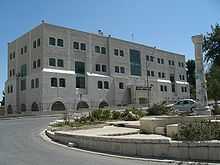
- Form of government: semi-presidential parliamentary democracy[2]
- Capital of Palestine:
- Proclaimed capital: East Jerusalem (also proclaimed by Israel)
- de facto capital: Ramallah
- Elections in the Palestinian territories
- Elections in the Palestinian National Authority
- Palestinian general election, 1996
- Palestinian presidential election, 2005
- Palestinian municipal elections, 2005
- Palestinian legislative election, 2006
- Next Palestinian general election
- PNA governments
- PNA government of October 2002
- PNA government of November 2003
- Palestinian government of March 2006
- PNA government of March 2007
- PNA government of June 2007
- Elections in the Palestinian National Authority
- Political parties of the Palestinian territories
- Political parties of the PNA
- Political parties of the PLO
- Taxation in the Palestinian territories
Branches of the government of the Palestinian territories
Executive branch of the PLO

Executive branch of the PNA
- Palestinian Authority
- President: Mahmoud Abbas
- President: Aziz Duwaik
- Prime Minister: Salam Fayyad
- Prime Minister: Ismail Haniyeh
- NB. As a result of the Fatah-Hamas conflict, there is a dispute over the Presidency and Prime Ministership of the Palestinian Authority.
- Ministries of the PNA
Legislative branches of the government of the Palestinian territories
- Palestinian Legislative Council (PNA, unicameral)
- Palestinian National Council (PLO, unicameral, parliament-in-exile[3])
Judicial branch of the government of the Palestinian territories
- According to the Constitution of Palestine, all courts relating to the country shall be independent.
Foreign relations of the Palestinian National Authority
- Diplomatic missions in Palestine
- Holy See – Palestinian relations
- India-Palestine relations
- Iran-Palestine relations
- Palestine-Russia relations
- Pakistan-Palestine relations
- Romania-Palestine relations
Palestine and the United Nations

- United Nations Partition Plan for Palestine
- United Nations Palestine Commission
- United Nations Relief and Works Agency for Palestine Refugees in the Near East (UNRWA)
- United Nations resolutions concerning Palestine
- United Nations Special Committee on Palestine (UNSCOP)
- Committee on the Exercise of the Inalienable Rights of the Palestinian People
- International Day of Solidarity with the Palestinian People
- Israel, Palestine, and the United Nations
International organization membership
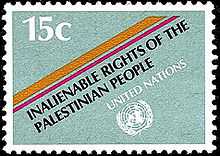
Palestine is a member in a number of international organizations. In others, it enjoys affiliation in a lesser capacity or under another designation (such as PLO or Occupied Palestinian Territory). In the list below, if the membership is not full or not for the state of Palestine, the type and name of affiliation is denoted in parentheses.
- Arab Fund for Economic and Social Development (AFESD)
- Arab League (AL)
- Arab Monetary Fund (AMF)
- Council of Arab Economic Unity (CAEU)
- FIFA (Asian Football Confederation (AFC)
- Group of 77 (G77)
- International Olympic Committee (IOC)
- International Trade Union Confederation (ITUC) (affiliate member)
- International Telecommunication Union (ITU) (non-voting observer status)
- International Organization for Standardization (ISO) (representation for 'Occupied Palestinian Territory' equivalent to that of a state)
- International Paralympic Committee (IPC)
- International Federation of Red Cross and Red Crescent Societies (IFRC)
- International Committee of the Red Cross (ICRC)
- Islamic Development Bank (IDC)
- Organisation of Islamic Cooperation (OIC)
- Non-Aligned Movement (NAM)
- United Nations (UN) (permanent observer with special privileges) (current representative:Riyad H. Mansour)
- UNESCO
- Universal Postal Union (UPU) (special observer status)
- World Health Organization (WHO) (observer status for the PLO) (see also: Palestine's application to the WHO)
- World Intellectual Property Organization (WIPO)
International aid to the Palestinian territories
International solidarity movements
- Palestinian solidarity organizations
Law and order in the Palestinian territories

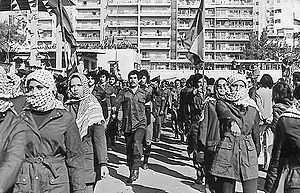
- Palestinian National Charter
- Crime in the Palestinian territories
- Human rights in the Palestinian territories
- Human rights in the Palestinian National Authority
- Freedom of religion in the Palestinian territories
- LGBT rights in the Palestinian territories
- Polygamy in the Palestinian territories
- Human rights organizations in the Palestinian territories
- Human rights record of Israel in the Occupied Palestinian Territories
- International law and Israeli settlements
- Israeli targeted killings
- Human rights in the Palestinian National Authority
- Law enforcement in the Palestinian territories
Military of the Palestinian territories
- Command
- Commander-in-chief: N/A
- Ministry of Defence of the Palestinian territories: N/A
- Commander-in-chief: N/A
- Forces
- Army of the Palestinian territories: N/A
- Navy of the Palestinian territories: N/A
- Air Force of the Palestinian territories: N/A
- Special forces of the Palestinian territories:
- Military history of the Palestinian territories
- Military ranks of the Palestinian territories: N/A
Paramilitary forces of the PNA
Irregular Palestinian forces
- Al-Aqsa Martyrs' Brigades (armed wing affiliated with Fatah)
- al-Quds Brigades (armed wing of Palestinian Islamic Jihad)
- Izz ad-Din al-Qassam Brigades (armed wing of Hamas)
- Popular Front for the Liberation of Palestine - General Command (PFLP-GC) (armed wing of the PFLP)
- Popular Resistance Committees
- Palestinian domestic weapons production
- Qassam rocket
- al-Quds rocket
- Rocket and mortar attacks on southern Israel
- Yassin RPG
- Al-Bana RPG
- Batar RPG
Israeli military and intelligence forces
- Central Command
- West Bank Division
- Coordinator of Government Activities in the Territories
- Israel Defense Forces checkpoint
- Paratroopers Brigade
- Shabak
International civilian forces
- European Union Border Assistance Mission Rafah
- European Union Police Mission for the Palestinian Territories
- Temporary International Presence in Hebron
Local government in the Palestinian territories
History of Palestine
- Main article: History of Palestine, Timeline of the history of Palestine, and Current events of Palestine
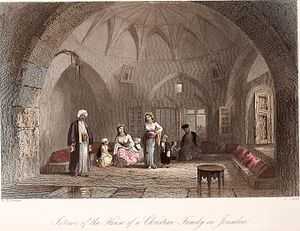

- Military history of Palestine
- Battle of Bitter Lakes (925 BCE)
- Siege of Gezer (c. 733 BCE)
- Siege of Gaza (332 BCE)
- Muslim conquest of Palestine (635 CE)
- Arab conquest of Roman Syria (634 - 638)
- Civil War in Palestine (793-796)
- Crusades (1095 - 1291)
- Battle of Wadi al-Khazandar (1299)
- Siege of Jaffa (1799)
- Siege of Acre (1799)
- 1834 Arab revolt in Palestine
- Sinai and Palestine Campaign (1915-1918)
- Battle of Megiddo (1918)
- 1920 Palestine riots
- Jaffa riots
- 1929 Palestine riots
- 1936–1939 Arab revolt in Palestine
- Bombing of Palestine in World War II
- 1948 Palestine war
- 1948 Palestinian exodus
- 1949-1956 Palestinian exodus
- Kfar Qasim massacre
- 1967 War
- 1967 Palestinian exodus
- Battle of Karameh
- Black September in Jordan (1970)
- 1982 Lebanon War
- Second Intifada (2000-ongoing)
- Gaza–Israel conflict
- Political history of Palestine
- Covenant of Umar I
- Jund Filastin
- Partitioning of the Ottoman Empire
- History of the Israeli–Palestinian conflict
- Palestine Jewish Colonization Association
- British Mandate Palestine
- Arab Higher Committee
- All-Palestine Government
- Palestine Liberation Organization
- Peace process in the Israeli–Palestinian conflict
- First Intifada
- Second Intifada
- Road map for peace
Palestinian culture
| Part of a series on |
| Palestinians |
|---|
 |
| Demographics |
|
| Politics |
|
| Religion / religious sites |
| Culture |
| List of Palestinians |




- Archaeology of the Palestinian territories
- Architecture of the Palestinian territories
- Costume of the Palestinian territories
- Cuisine of the Palestinian territories
- Festivals of the Palestinian territories
- Al-Quds Capital of Arab Culture
- Boston Palestine Film Festival
- Chicago Palestine Film Festival
- Feast of Saint George
- Khader Grape Festival
- Thursday of the Dead
- Palestine Festival of Literature
- Nabi Musa (pre-1948)
- Nabi Rubin (pre-1948)
- Al-Nabi Yusha' (pre-1948)
- Languages of the Palestinian territories
- Media in the Palestinian territories
- Print media of the Palestinian territories
- Palestinian Broadcasting Corporation
- Radio in the Palestinian territories
- Television in the Palestinian territories
- Al Aqsa TV
- Palestinian Satellite Channel
- National symbols of Palestine
- Coat of arms of Palestine
- Palestinian Flag
- Flag of the British Mandate of Palestine
- Keffiyeh
- National anthem of Palestine
- Palestinian nationalism
- Sumud
- Palestinians
- Arab citizens of Israel
- Internally displaced Palestinians
- Negev Bedouins
- Palestinian diaspora
- Palestinian prisoners in Israel
- Palestinian refugees
- Prominent Palestinians
- Prostitution in the Palestinian territories
- National holidays of the Palestinian territories
- Records of the Palestinian territories
- Religion in the Palestinian territories
- Christianity in the Palestinian territories
- Eastern Orthodox
- Greek Orthodox Church
- Brotherhood of the Holy Sepulchre
- Greek Orthodox Patriarch of Jerusalem
- Arab Orthodox
- Church of the Nativity
- Church of Saint Porphyrius
- Monastery of Saint George, al-Khader
- Monastery of the Temptation
- Arab Orthodox
- Greek Orthodox Patriarch of Jerusalem
- Brotherhood of the Holy Sepulchre
- Greek Orthodox Church
- Oriental Orthodoxy
- Armenian Patriarch of Jerusalem
- Latin Rite
- Latin Patriarch of Jerusalem
- Church of Saint Lazarus
- Latin Patriarch of Jerusalem
- Eastern Catholic Churches
- Anglican Communion
- Episcopal Church in Jerusalem and the Middle East
- Anglican-German Bishopric in Jerusalem
- Anglican Bishop of Jerusalem
- Anglican-German Bishopric in Jerusalem
- Episcopal Church in Jerusalem and the Middle East
- Protestantism
- Church of the Holy Sepulcher
- Eastern Orthodox
- Druzism in the Palestinian territories
- Islam in the Palestinian territories
- Waqf
- Jerusalem Islamic Waqf
- Haram al-Sharif
- Imaret
- Hasseki Sultan Imaret
- Moroccan Quarter
- Sabil Abu Nabbut
- List of mosques in Israel and the Palestinian territories
- Jerusalem Islamic Waqf
- Supreme Muslim Council
- Waqf
- Sites holy to Christians, Jews, and Muslims
- Cave of the Patriarchs (Al-Haram Al-Ibrahimi)
- Joseph's Tomb
- Jacob's Well (also holy to Samaritans)
- Rachel's Tomb (Bilal ibn Rabah)
- Tomb of Samuel (Nabi Samwil)
- Judaism in the Palestinian territories
- Palestinian synagogues
- Ancient Synagogue of Gaza
- Samaritans in Palestine
- Christianity in the Palestinian territories
Art in the Palestinian territories
- Art in the Palestinian territories
- Museums in the Palestinian territories
- Cinema of the Palestinian territories
- Handicrafts of the Palestinian territories
- Literature of the Palestinian territories
- Music of the Palestinian territories
- Theatre in the Palestinian territories
Sports and leisure in the Palestinian territories
- Football in the Palestinian territories
- Palestine national football team
- Palestinian Football Federation
- Hammams (bathhouses)
- Palestine Olympic Committee
- Palestine at the Paralympics
- Palestinian Scout Association
- Girl Guides of Palestine
Economy and infrastructure of the Palestinian territories
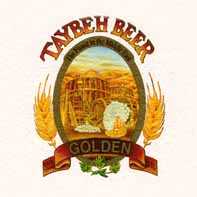


- Economic rank, by nominal GDP (2007): 134th (one hundred and thirty fourth)
- Agriculture in the Palestinian territories
- Banking in the Palestinian territories
- Arab Bank
- National Bank of Palestine
- Communications in the Palestinian territories
- Internet in the Palestinian territories
- Telephone numbers in the Palestinian territories
- Companies of the Palestinian territories
- National Trade Union of Palestine
- Fair Trade organizations in the Palestinian territories
- Currency of Palestine: Dinar/Sheqel
- Economy of Gaza
- Energy in the Palestinian territories
- Energy policy of the Palestinian territories
- Oil industry in the Palestinian territories
- Health care in the Palestinian territories
- Housing in the Palestinian territories
- Mining in the Palestinian territories
- Public squares in the Palestinian territories
- Manger Square
- Palestine Square
- Soldier's Square
- Tourism in the Palestinian territories
- Transport in the Palestinian territories
- Airports in the Palestinian territories
- RAF Haifa (1942–1948) (now Haifa Airport in Israel)
- Wilhelma Airport (1936–1948) (now Ben-Gurion Airport in Israel)
- Yasser Arafat International Airport (1998–2001)
- Rail transport in the Palestinian territories
- Palestine Railway (1891–1948)
- Port of Gaza
- Roads in the Palestinian territories
- Airports in the Palestinian territories
- Water supply and sanitation in the Palestinian territories
- Palestine Stock Exchange
Education in the Palestinian territories

- Education Minister of the Palestinian National Authority
- Universities and colleges of the Palestinian territories
- Student organizations in the Palestinian territories
- Student organizations for the Palestinian territories
- Palestinian cultural club
- Palestine Solidarity Movement
- Solidarity for Palestinian Human Rights
- Students for Justice in the Palestinian territories
- Students for the Palestinian territories
Books on the Palestinian territories
- Correcting a Mistake: Jews and Arabs in Palestine/Israel, 1936-1956
- The Ethnic Cleansing of Palestine
- Palestine (comics)
- Palestine Peace Not Apartheid
- Underground to Palestine
See also
| Arabic language edition of Wikipedia, the free encyclopedia |
- Index of Palestine-related articles
- List of international rankings
- List of Palestine-related topics
- Years in the Palestinian territories
- Outline of Asia
- Outline of geography
- Outline of Israel
References
- ↑ "Note that the term Palestine has historically referred to the region which today incorporates Israel as well as the Palestinian territories. The current position was expressed by Mahmoud Abbas in his September 2011 speech to the United Nations: 'When we adopted this program, we were taking a painful and very difficult step for all of us, especially those, including myself, who were forced to leave their homes and their towns and villages, carrying only some of our belongings and our grief and our memories and the keys of our homes to the camps of exile and the Diaspora in the 1948 Al-Nakba, one of the worst operations of uprooting, destruction and removal of a vibrant and cohesive society that had been contributing in a pioneering and leading way in the cultural, educational and economic renaissance of the Arab Middle East. Yet, because we believe in peace and because of our conviction in international legitimacy, and because we had the courage to make difficult decisions for our people, and in the absence of absolute justice, we decided to adopt the path of relative justice - justice that is possible and could correct part of the grave historical injustice committed against our people. Thus, we agreed to establish the State of Palestine on only 22% of the territory of historical Palestine - on all the Palestinian Territory occupied by Israel in 1967.'"
- ↑ Martijn Schoonvelde (26 June 2009). "Palestinian Territories". Retrieved 2009-07-26.
- ↑ Sela and Ma'oz, 1997, p. 16.
Bibliography
- Roberto Remo Bissio, ed. (1995). The world: a Third World guide 1995-96 (Illustrated ed.). Instituto del Tercer Mundo. ISBN 9780855982911.
- Milton-Edwards, Beverley (2008), The Israeli-Palestinian Conflict: A People's War (Illustrated ed.), Taylor & Francis, ISBN 9780415410434
- Kogan Page (2004). Middle East Review (27th, illustrated ed.). Kogan Page Publishers. ISBN 9780749440664.
- Said, Edward W.; Hitchens, Christopher (2001), Blaming the victims: spurious scholarship and the Palestinian question (2nd, illustrated ed.), Verso, ISBN 9781859843406
- Sela, Avraham; Ma'oz, Moshe (1997), The PLO and Israel: from armed conflict to political solution, 1964-1994 (Illustrated ed.), Palgrave Macmillan, ISBN 9780312129064
External links
| Wikimedia Commons has media related to Palestinian territories. |
- The Hope Simpson Report (London, 1930)
- Palestine Royal Commission Report (the Peel Report) (London, 1937)
- Report to the Council of the League of Nations (1928)
- Report to the Council of the League of Nations (1929)
- Report to the Council of the League of Nations (1934)
- Report to the Council of the League of Nations (1935)
- www.mideastweb.org - A website with a wealth of statistics regarding population in Palestine
- Coins and Banknotes of Palestine under the British Mandate
- WorldStatesmen- Maps, flags, chronology, see Israel and Palestinian National Authority
- hWeb - Israel-Palestine in Maps
- Palestine Fact Sheet from the Common Language Project
- 1911 Encyclopedia description of Palestine
- Liberal Democrat Friends of Palestine
- History of the Palestine Problem, UN website
- Maps
 Media related to maps of the Palestinian territories at Wikimedia Commons
Media related to maps of the Palestinian territories at Wikimedia Commons- Sykes-Picot Agreement, 1916
- 1947 UN Partition Plan
- 1949 Armistice Lines
- Israel After 1949 Armistice Agreements
- Liberal Democrat Friends of Palestine
| ||||||


